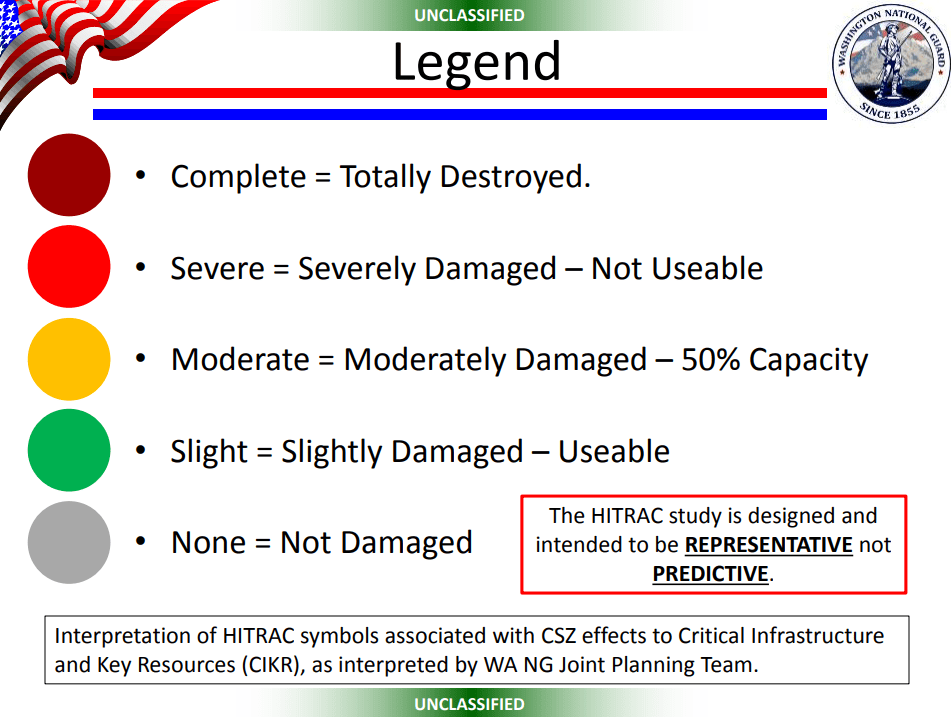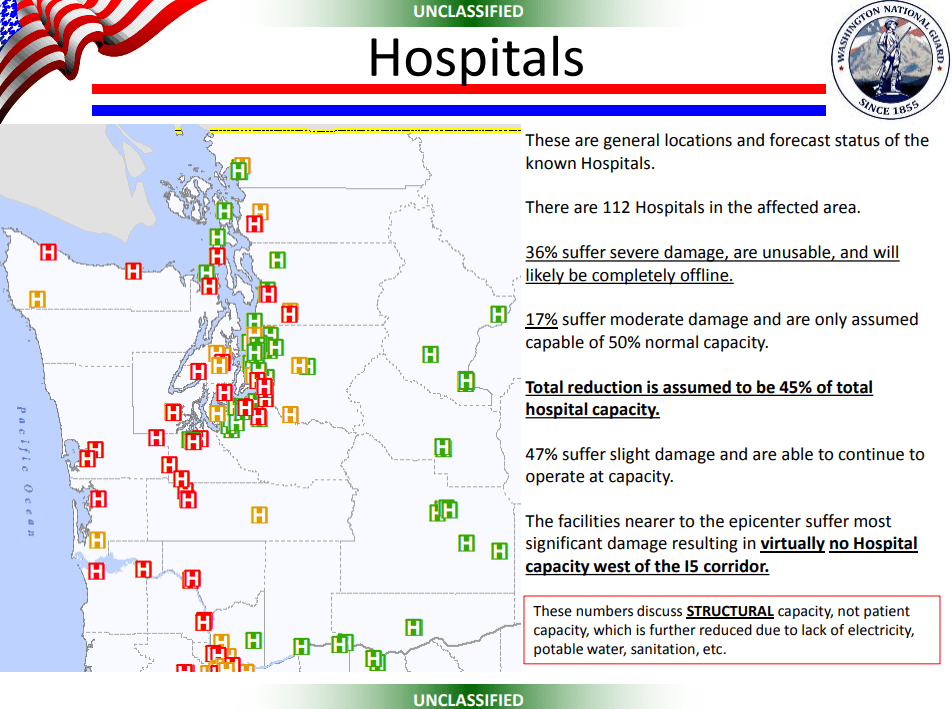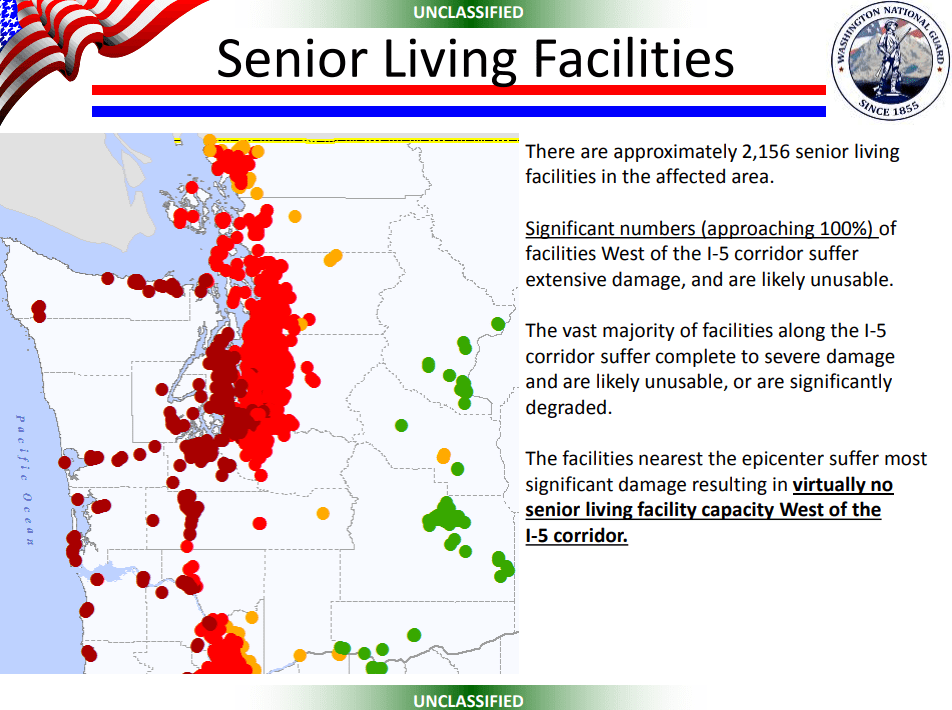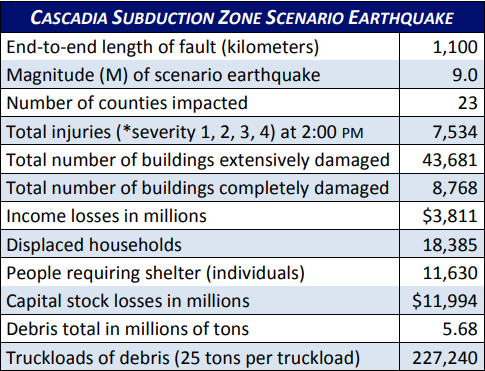A magnitude 9.0 earthquake hitting the Pacific Northwest can be hard to imagine. What will it be like? How will the region be affected? This page provides some answers to how Washington may (these are expected, not certainties) be impacted.
There is a need for Washington residents to prepare. A Cascadia Subduction Zone rupture would destroy transportation systems and isolate many Western Washington communities. Cascadia Rising confirmed that it could take several weeks for assistance to reach communities that have become isolated because of the earthquake impacts.
Washington State 2016 Cascadia Rising Exercise, After-action Report
The Washington Emergency Management division of the Washington Military Department released tsunami loss estimates for the state by county.
- 2:00 a.m. mid-summer CSZ M9 scenario (assumes full occupancy for overnight visitors and residents, does not include daytime visitors).
- A 10-minute delay refers to someone beginning their evacuation 10 minutes after the earthquake shaking begins. Shaking is estimated to last between 3 – 6 minutes, so this would be a very fast departure, allowing only 4 to 7 minutes for gathering people, pets and supplies. Have go-bags and evacuation plans in place ahead of time.
- Note the minimal number of injuries caused by the tsunami vs the number of fatalities. Visit Surviving Cascadia’s Tsunami page for infomation about survival rates of those caught up in tsunamis over 6.5 feet deep.
- By comparison, DOGAMI’s Earthquake and Tsunami Impact Analysis for the Oregon Coast states, “[Oregon] Fatalities caused by the tsunami will be devastating. We estimate ~4,550 (M1) to ~14,000 (XXL1) residents killed, and potentially another ~11,000 (M1) to ~31,700 (XXL1) visitors killed,” equating to the potential for nearly 110,000 fatalities between the two states alone.
- Below is a snipit of data from their WA State CSZ Tsunami Loss Estimate Study Spreadsheets (Visit the link for full details). Of the casualties listed, the ratio is 2.37% injuries to 97.63% fatalities. Being swept up in a tsunami is incredibly dangerous and the best way to survive a tsunami is to get to high ground before the waves hit.

- Estimated population within high hazard seismic zones: 5.7 million.
- Projected population within high hazard seismic zones by 2050: 6.4 million – 6.6 million
- Estimated socially vulnerable population within high hazard seismic zones: 2.6 million
- Estimated population exposed to the direct or indirect impacts of earthquakes: 7.5 million
- Estimated State-owned or -leased facilities within high hazard seismic zones and dollar value: 7,300, $108
billion - Estimated miles of public roads located in high hazard seismic zones: 32,000
- Critical intermodal transportation facilities located high hazard seismic zones: 21
- Number of licensed hospitals in high hazard seismic zones: 71
- Number of first responder facilities in high hazard seismic zones: 1,071
- Number of power plants and miles of electric power transmission lines high hazard seismic zones: 73 power
plants, 7,300 miles of transmission lines - Number of public drinking water supplies in high hazard seismic zones: 11,000
- Number of publicly owned wastewater treatment plants in high hazard seismic zones: 4







Modeling a Magnitude 9.0 Earthquake on the Cascadia Subduction Zone off the Pacific Coast
Table 1. Summary of significant losses in the M9.0 Cascadia subduction zone earthquake scenario.
Report created by Washington Military Department, Washington State Department of Natural Resources, USGS & FEMA
“Structural collapse (complete damage) of thousands of buildings is also expected (more than 3,000 in Clallam County).”
Coastal Estimated Impacts
- Washington Tsunami inundation zone population: Over 163,000
- Short-term sheltering needs: 93,000 people, including 15,000 people with Access and Functional Needs
- Short-term feeding and hydration needs: 288,000 people, including 51,000 people with Access and Functional Needs
- Tribal coastal population short-term sheltering needs: 14,500; 2,100 with Access and Functional Needs
- Injuries: between 5,000 and 29,000
- Deaths: between 9,100 and 16,578
I-5 Corridor Estimated Impacts
- Short-term sheltering needs: 57,000 people, including 13,500 people with Access and Functional Needs
- Short-term feeding and hydration needs: 1,600,000 people, including 794,000 people with Access and Functional Needs
- Tribal population short-term sheltering needs: 116,500; 14,500 with Access and Functional Needs
- Injuries: between 7,000 and 25,000
- Deaths: between 300 and 1,600

As with the Expected Impact: Region page, where you find discrepancies between the sources below, note that earthquake scenario assumptions (season, time of day) cause variations in the estimates, and the year the document was written plays a role, as well. Population continues to grow in these regions, affecting the number of people at risk. New assessments are being conducted. New science is being learned. These are just estimates.
All reports come from data that explores the impacts of a 9.0+ (full-margin rupture) scenario, but it’s important to remember partial ruptures are also common. Separators are used between information sources.
